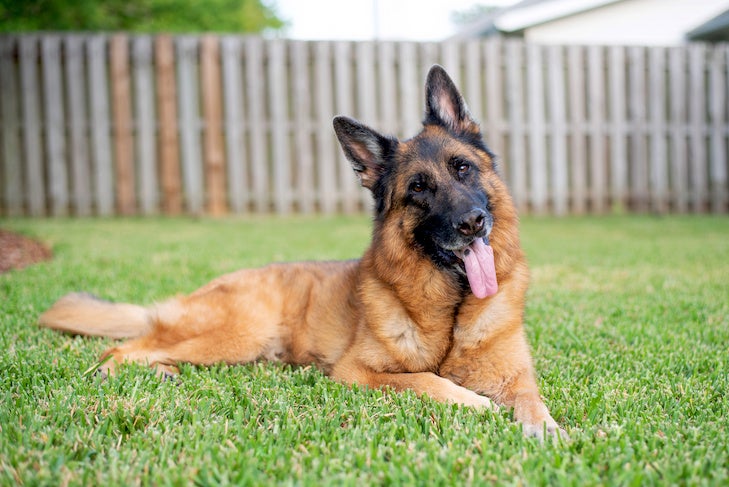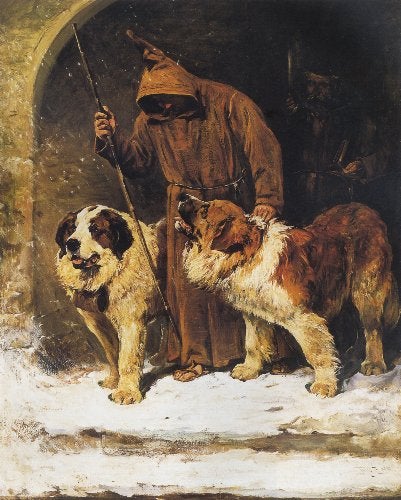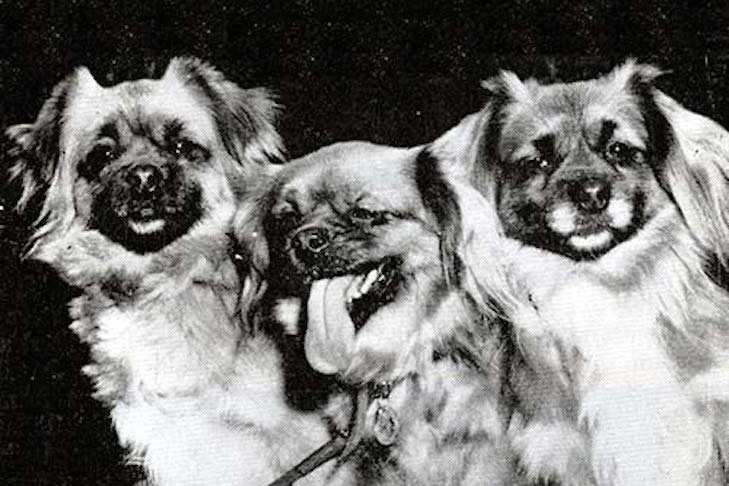
The ability of dogs to put us humans in touch with our own spirituality, to draw our focus out of ourselves and cause us to reflect upon the wonders of nature, has not gone unrecognized by those who would perhaps understand this best. Dogs have long held a special place at monasteries worldwide, and certain dog breeds have been particularly favored by monks, both ancient and modern. Here are just a few of the AKC-recognized breeds beloved by monks.
German Shepherd Dog
The Monks of New Skete are legendary as breeders and trainers of German Shepherd Dogs, and their decades-long experience with GSDs in upstate New York has led them to offer their highly-sought-after training intensives to all breeds. They are the authors of multiple training manuals and books about dogs, including the bestsellers How to Be Your Dog’s Best Friend and The Art of Raising a Puppy.
The German Shepherd Dog consistently ranks as one of America’s most popular dogs, and is often referred to as “dogkind’s finest all-purpose worker.” Their high intelligence and love of work demands thoughtful, consistent, and constant training; they thrive when given multiple outlets for their athletic energy and clever minds. Thankfully, due to their versatility and ability to participate in almost any dog sport or canine occupation, this is easily accomplished by the owner who is willing to commit the necessary time.

Saint Bernard
Centuries ago, in the snowy Swiss Alps, monks at the Great St. Bernard Hospice developed a breed of dog through crossbreeding between Mastiff types and native dogs in Switzerland. This new breed would become best known for its ability in search and rescue, a skill that was much needed for the travelers who often lost their way in the snowbound mountains. In fact, the Great St. Bernard Pass, the oldest known pass through the Western Alps—and one of the highest passes in Switzerland—was particularly treacherous for travelers, given that it was isolated and covered in blankets of snow for most of the year.
The Saint Bernard was originally used not only as a rescue dog (a role in which the breed became legendary), but also as a watchdog and companion to the monks and their guests. It has been estimated that the Hospice’s Saint Bernards saved over 2,000 lives. Today, the Saint Bernard remains a lovable and trusted companion.

Lhasa Apso
The Lhasa Apso originated in the valleys of the Himalayas, particularly near Lhasa, the capital of Tibet. In its native land, the Lhasa Apso is called Apso Seng Kyi, which roughly translates to “bearded lion dog.” The Lhasa served primarily as an indoor sentinel for Tibetan nobility and Buddhist monks, and they often served as a “backup alarm” for Tibetan Mastiffs (see below). They were highly prized in their native Tibet as loyal companions and indispensable watchdogs. Receiving a Lhasa as a gift was a great honor.
In keeping with their original function as household sentinels, Lhasas have keen hearing and an instinctive suspicion of strangers. They are often described as intelligent dogs with a regal and independent attitude that disguises a deep sense of humor and joie de vivre.

Chow Chow
The origins of the Chow Chow remain shrouded in mystery, but this ancient breed is most often associated with China and has been called the “Emperor of Dogs.” Dogs similar in appearance to today’s Chow Chow can be seen in Chinese pottery and sculptures dating as far back as the Han Dynasty (206 BCE – 220 CE). Later, with the development of Buddhism in the sixth century, Tibetan monks used Chow Chows as guard dogs in their monasteries.
The Chow has been used as a hunter, herder, and carting dog as well as a guardian. There are reports that, during the Tang Dynasty (690 CE – 907 CE), one Chinese emperor kept 2,500 Chow Chows to accompany his 10,000 hunters! This breed is known for being serious-minded and dignified, with a certain degree of aloofness toward strangers. Some rural monasteries in China still breed Chow Chows (usually of the rarer blue color) today.

Tibetan Mastiff
Known as Do Kyi, or “tied dog,” to the Tibetan nomads who originally developed the breed, the Tibetan Mastiff has been used for centuries to guard the ancient monasteries of Tibet. They are thought to be one of the oldest breeds in existence, and are believed to be the foundation from which most of the modern large working breeds have developed.
Given the terrain in which this breed originated, the Tibetan Mastiff is suited to high altitudes with cold temperatures. These are massive, fearless dogs who are to this day used as guard dogs and protectors of family and property. In Tibet, they continue to guard monasteries, homes, nomadic caravans, and even entire villages—such is their power and prowess.

Tibetan Spaniel
For centuries, the Tibetan Spaniel has been a fixture in the thousands of monasteries across Tibet, serving as both watchdog and constant companion. Like the Lhasa Apso, the Tibetan Spaniel worked in tandem with the Tibetan Mastiff at many monasteries. The “Tibbies,” as they are now affectionately known, were farseeing sentinels who sat atop monastery walls and could sound the alert upon the approach of friend or foe.
Tibetan Spaniels display a deep devotion to people, and today excel at therapy work. They have even served as hearing dogs for the deaf. They are charming, playful companions whose cheerful self-confidence far exceeds their size.

Tibetan Terrier
Some 2,000 years ago, in the Lost Valley of Tibet, Lamaist monks and local communities developed this hardy, compact, and agile breed. Known as the “Holy Dog of Tibet,” Tibetan Terriers have served in a wide range of roles, including livestock guardians and herders, monastery sentries, and all-purpose caravan dogs.
Interestingly, the Tibetan Terrier is not a terrier at all, but was given this name by the English because they resembled neither gun dogs nor mastiffs. Today’s TT is primarily a companion—yet another job at which this breed excels, given its affectionate, sensitive, clever, and captivating temperament.

Yasmine S. Ali, MD is a cardiologist and writer in Tennessee, where she lives with two Canine Good Citizens, including an AKC-registered German Shepherd Dog.

